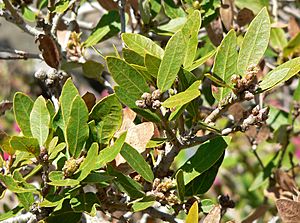Huckleberry oak facts for kids
Quick facts for kids Huckleberry oak |
|
|---|---|
 |
|
| Scientific classification | |
| Genus: |
Quercus
|
| Species: |
vacciniifolia
|
| Synonyms | |
|
|
The Huckleberry Oak, also known by its scientific name Quercus vacciniifolia, is a special kind of Oak plant. It's part of the Protobalanus group within the oak family. This plant is unique because its leaves stay green all year round.
It produces acorns that are very bitter. These acorns take about 18 months to fully grow and ripen. The inside of the acorn shell is covered in a soft, woolly fuzz.
Contents
What is the Huckleberry Oak Like?
The Huckleberry Oak is a small, bushy plant. It's an evergreen, meaning its leaves stay green through all seasons. This plant usually grows less than 1.5 meters (about 5 feet) tall. It spreads out wide instead of growing into a tall tree.
You can often spot a Huckleberry Oak by looking at its buds. Like all oak plants, its buds grow in clusters at the end of its branches. It's easiest to tell it apart from other plants when it has acorns.
How Huckleberry Oak Acorns Grow
The acorns of the Huckleberry Oak take two years to fully mature. This means they grow for a long time after the flowers are pollinated.
The Huckleberry Oak can sometimes be confused with another plant called the Cedros Island oak. The main difference is in their leaves. Huckleberry Oak leaves have smooth edges or tiny, pointed tips. Cedros Island oak leaves have uneven, spiky teeth along their edges.
Where Does the Huckleberry Oak Live?
The Huckleberry Oak is found naturally in the western parts of the United States. You can see it growing in the Sierra Nevada mountains in California. Its range also reaches into Nevada.
It also grows in the Klamath Mountains and the southern Cascade Range. You can find it as far north as southern Oregon. This plant prefers to live in high mountain forests. It also grows in areas of mountain chaparral, which are dry, shrubby lands.
Huckleberry Oak's Mountain Home
The Huckleberry Oak likes to grow on steep slopes and ridges. It's often found in conifer forests and sub-alpine forests. These are high mountain areas, usually at altitudes from 150 to 2930 meters (about 490 to 9,600 feet).
While it's native to California, you can also find it in Oregon and Nevada. Sometimes, the Huckleberry Oak mixes with another oak species, Q. chrysolepis. When they grow together, they can create new hybrid plants. This happens a lot in the Sierra Nevada mountains.
Huckleberry Oak and Wildfires
Long ago, between 11,000 and 5,000 years ago, Huckleberry Oaks were very common. They grew in large numbers in the Klamath Mountains, especially where the soil was rich in certain minerals. During that time, Huckleberry Oaks helped spread wildfires. This was because they were abundant, medium-sized, and had resinous (sticky) leaves that burned easily.
Today, Huckleberry Oaks usually don't form such thick, dense stands. This allows other plants that can resist fire to grow among them.
How Animals and People Use Huckleberry Oak
Many animals rely on the Huckleberry Oak for food. Mule deer enjoy eating its leaves. Many birds and mammals, including the American black bear, eat its acorns.
People also use the Huckleberry Oak for important environmental projects. It's used in ecological restoration to help damaged areas recover. It's also planted for revegetation to bring plants back to bare land. Gardeners sometimes use it in landscaping.
This plant is very good at preventing erosion. For example, it's planted on the slopes above Lake Tahoe. This helps slow down soil erosion, which keeps the lake cleaner.
See also
 In Spanish: Quercus vaccinifolia para niños
In Spanish: Quercus vaccinifolia para niños

